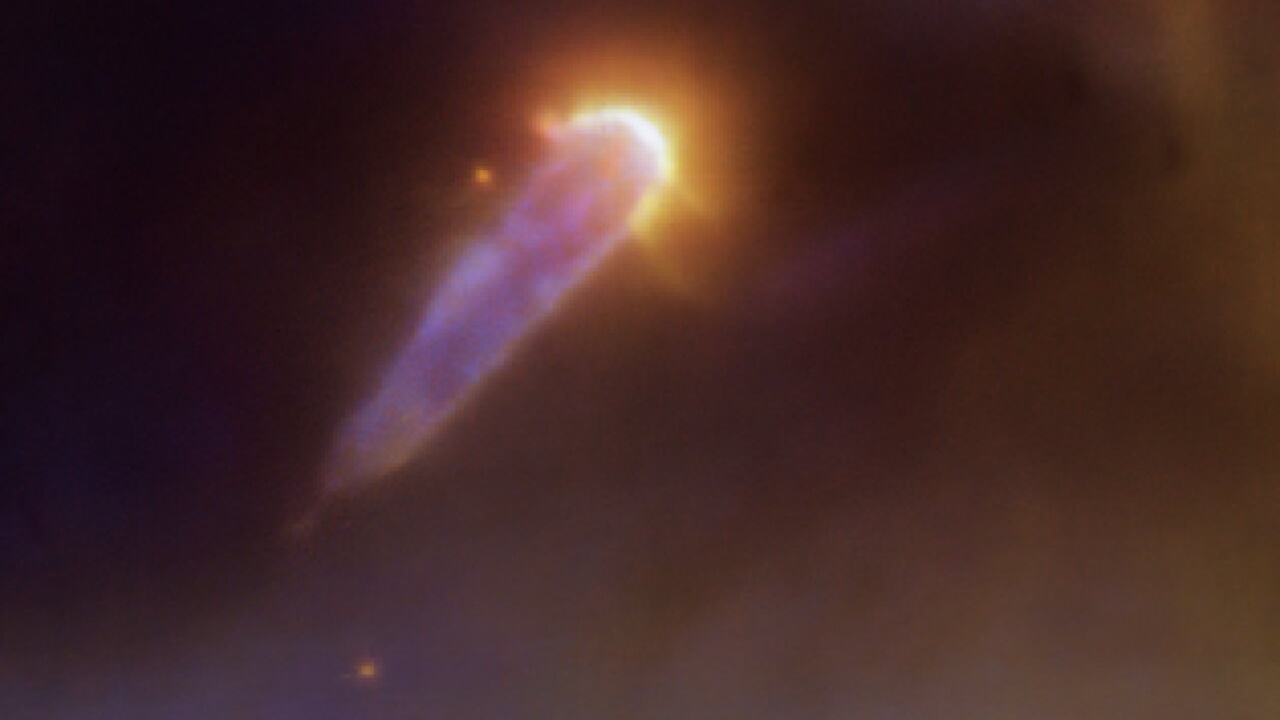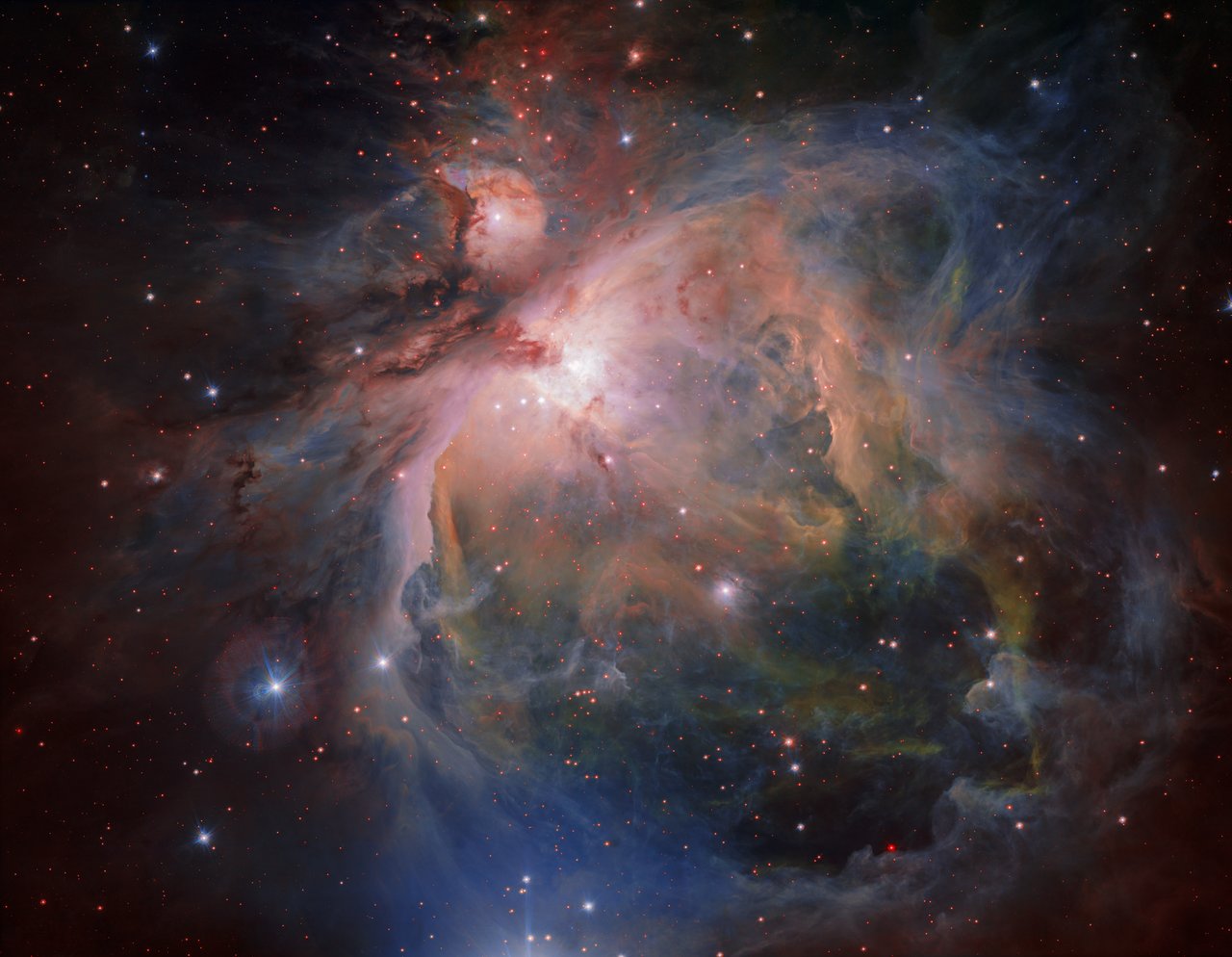This planet-forming disk shaped like a comet is struggling to survive
A new image of a proplyd with a comet-like appearance has deepened the mystery of these radiation-proof planetary nurseries.

In the Orion Nebula lies a host of bizarre, teardrop-shaped objects. They look like strange comets, but are in fact evaporating, planet-forming disks around young stars. Astronomers are perplexed by the existence of these disks, because they should have been destroyed long ago.
This puzzling nature, however, makes them enticing targets for study — and a new image, taken by the Multi Unit Spectroscopic Explorer (MUSE) instrument on the Very Large Telescope in Chile, has done just that. This image brightly showcases one of these peculiar objects, designated 177-341 W.
Related:
It's a type of body called a proplyd, which is a portmanteau of "ionized protoplanetary disk." Proplyds were first spotted in the Orion Nebula, which is 1,344 light-years away, in the mid-1990s by astronomers using the Hubble Space Telescope. Their planet-forming disks are being eroded by powerful ultraviolet light emitted from massive stars in the nebula, principally the bright and hot star called theta-1 Orionis C. This is the stand-out of the four main stars that make up the Trapezium, which is the central young stellar cluster at the heart of the Orion Nebula.
Theta-1 Ori C is so massive (33 times the mass of our sun, in fact) that it belongs to the hottest class of stars, which are O-type stars on the Hertzsprung–Russell diagram of stellar evolution. It also shines with a luminosity 204,000 times greater than our sun shines, meaning it produces a heck of a lot of ultraviolet radiation that ionizes everything for light-years around. Proplyds are the unfortunate young planetary systems that get in the way of that ultraviolet radiation.
In MUSE's image of 177-341 W, the bright arc, or cusp, around the top of the proplyd is where the powerful torrent of ultraviolet radiation from theta-1 Ori C is slamming into the gentler stellar wind flowing from the star at the heart of 177-341 W. This interaction is creating a shockwave.
Such ultraviolet radiation also heats the surface of the planet-forming disk of gas and dust, and as the gases on the surface of the disk warm up, they expand and are subject to being dragged away by the stream of ultraviolet radiation. This forms the proplyd's comet-like "tail," which is pointing diametrically opposite theta-1 Ori C (it lies out of the frame beyond the top-right corner).
Get the Space.com Newsletter
Breaking space news, the latest updates on rocket launches, skywatching events and more!
A total of 178 proplyds have been discovered so far in the Orion Nebula. That's potentially indicative of the births of 178 planetary systems beyond those that have already formed there. We say "potentially" because there is one big caveat: the Proplyd Lifetime Problem.

As ultraviolet radiation drags material out of the disks that would otherwise go into forming planets, the disks lose mass. Thus, given the age of the Orion Nebula is between 2 to 3 million years old, there should have been plenty of time for proplyds to have completely evaporated, preventing substantial planetary systems from forming. In the most extreme cases, theta-1 Ori C should prevent any planets from forming at all! And yet, we still see the proplyds. Is our estimate of how much mass they lose incorrect?
A team of astronomers led by Mari-Lilis Aru of the European Southern Observatory used MUSE's observations of 12 proplyds in the Orion Nebula, including 177-341 W, to try to answer that question. They found that the proplyds are losing mass at rates between 1.07 and 94.5 x 10–7 solar masses — in other words, between 10 millionths and 945 millionths of the mass of the sun each year. This is consistent with previous estimates of the mass-loss rate. And, at that rate, the proplyds should have evaporated by now. We shouldn't be able to see them.
—
—
—
So, the mystery remains, and proplyds will continue to be the subject of intense observation and debate in the coming years as researchers try to figure out what allows them to persist and form planets in the face of such torrential ultraviolet radiation.
The findings from Aru's team are to be published in the journal Astronomy & Astrophysics. A preprint of their work is available online.
Join our Space Forums to keep talking space on the latest missions, night sky and more! And if you have a news tip, correction or comment, let us know at: community@space.com.

Keith Cooper is a freelance science journalist and editor in the United Kingdom, and has a degree in physics and astrophysics from the University of Manchester. He's the author of "The Contact Paradox: Challenging Our Assumptions in the Search for Extraterrestrial Intelligence" (Bloomsbury Sigma, 2020) and has written articles on astronomy, space, physics and astrobiology for a multitude of magazines and websites.









